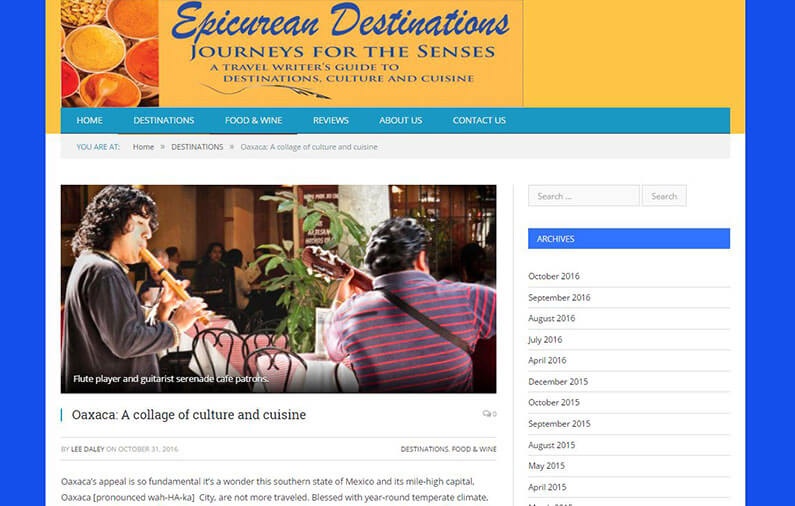Oaxaca: A collage of culture and cuisine

Oaxaca’s appeal is so fundamental it’s a wonder this southern state of Mexico and its mile-high capital, Oaxaca (pronounced wah-HA-ka) City, are not more traveled. Blessed with year-round temperate climate, nearby archeological ruins, distinctive cuisine and magnificent artisan handicrafts, the 16th century settlement nestles in a temperate highland valley and enjoys year-round abundant sunshine. Oaxaca’s zocalo, its central open-air plaza, radiates the warmth of its people. Amid a hubbub of surrounding bustle there is a friendly welcoming calm.
Children chase balloons under the watchful eye of an older sibling; locals relax on wrought-iron benches reading the daily news or chatting with friends. Mature shade trees shelter al fresco barber chairs occupied by men resembling vaqueros in jeans and cowboy boots. Sit or stand in this vibrant physical heart of the city and you’ll soon surmise that nearly every Oaxaqueño passes through at least once a day.
It was Oaxaca’s unpretentious feel that cast a spell over me as I wandered its cluttered cobbled streets. Each evening, colored lights would blink as strolling street musicians and señoras selling hand crocheted shawls plied the tables at open-air cafes. Mariachis vied for attention with lively folkloric dancers. In a way, it reminded me of the small town where I spent my childhood, where I knew all the kids in town and the adults watched out for us. Oaxaca is still, even today, living theater, ongoing and evolutionary, with a different show every night.
Sightseeing: The best way to immerse yourself in the local culture is by strolling the clean streets that fan out from the zocalo. Splendid examples of Baroque colonial architecture mix with brightly hued adobe buildings. Museums abound. Pressed for time, choose the centrally located Rufino Tamayo Museo de Arte on Avenida Morelos which contains a fantastic collection of pre-Hispanic art amassed by Oaxacan artist Rufino Tamayo over a 20-year period.
With 27 churches in town, the city is truly blessed. Oaxaca’s crown jewel is the Basilica de la Soledad. Built to house a statue of the city’s patron saint, the Virgin of Solitude, it boasts a façade 79 feet high. Another treasure is the Santo Domingo Church. When the sun shines through the church’s stained-glass window, it’s said to create a golden glow over the entire interior that resembles a Baroque vision of heaven.
Recognizing Oaxaca’s cultural wealth, expat entrepreneurs have opened art galleries, cafes, inns and cooking schools. Nary a week goes by without an opening at one of the more than 50 galleries and artists’ studios in town. I stopped in at the Oaxaca Lending Library on Pino Suarez. Coffee and conversation were brewing and I ended up chatting with several expats. One transplanted Texan told me how, on Saturday mornings, local Mexicans pair up with English-speaking visitors for language practice exchanging one hour in Spanish for another in English. Oaxaca’s cross-cultural vibe was infectious. I found myself wanting to linger longer. www.oaxlibrary.org
Cuisine: Known as the “Land of the Seven Moles,” Oaxaca’s cuisine is world renowned for its chocolate, coffee and mole, a savory dish which usually includes chocolate. Endless versions of mole exist, differing from family to family. Without question, Oaxaca is the undisputed epicenter of this intoxicating blend of chocolate, chilies, garlic, onions, nuts and more. And it’s been going on for centuries. Early explorers who drank the native hot chocolate brought the tradition home to Europe with them. In warm weather, cafes serve a drink called tejate. Made with chocolate, masa, flowers and fruit pulp, the ingredients are blended into a cool frothy drink, especially refreshing in summer. High-altitude Oaxacan coffee produces a mild, sweet, complex brew that satisfies without that feeling of having had one too many. Not much of a coffee drinker at home, I soon became addicted.
Branching Out: More cultural treasures await outside the city in the three surrounding valleys ringed by Zapotec and Mixtec ruins. Centuries ago, on a mountain top high above Oaxaca City, Zapotec Indians built the magnificent ceremonial center of Monte Alban. From there, they ruled thousands of square miles. Their descendants still work the ancient trades and crafts today; their high quality products are prized buys.
Especially desirable are the hand-loomed carpets. The elaborately painted wood carvings called alebrijes and lustrous black pottery are take-home treasures too. Every weekday one village or another holds a market day. Day trips to the markets are easily arranged by your hotel and are within driving distance. Markets present a great opportunity to engage in respectful negotiation with a native craftsperson. Even more valuable than the purchase of a one-of-a-kind art piece is knowing you have been part of a positive cross cultural exchange. Unfazed by passers through, Oaxacans keep on giving in their own humble way, sharing generously their traditions, their culture, their cuisine and most of all their inclusive culture of acceptance.
Where to Stay: Oaxaca offers a wide range of accommodations from luxury resorts to home stays.
Hacienda Los Laureles. Secluded in the privacy of gardens, this upscale early 1800s hacienda is just ten minutes walk from the city center. Travelers who appreciate retiring to a tranquil retreat will find it here. Guests can take cooking classes in the garden, avail themselves of the full-service spa and enjoy fine dining in the hacienda’s Cypress Restaurant. haciendaloslaureles.com.
Hotel Casa Antigua: Close to town, in a remodeled 19th century house with panoramic views from the terrace, the hotel offers mid-range pricing with continental breakfast. Calle 5 de Mayo 206, www.hotelcasaantigua.com.
Casa de Las Bugambilias is a family-owned bed-and-breakfast inn with nine individual rooms all enhanced by original art works. Lovely quiet garden in a central locale. Excellent two-course breakfast included. Modestly priced. http://www.lasbugambilias.com
Package specials: www.mexicoboutiquehotels.com Arranging your stay through Mexico Boutique Hotels is a great way to avail yourself of first class service. Member hotels throughout the country are carefully screened. Their complimentary concierge service can arrange or confirm transportation, make reservations and give an added degree of security and comfort to your travel plans in Mexico.Toll-free (800) 728-9098 or (877) 278-8018.
When to Go: Year-round Oaxaca enjoys temperate climate. May through September is mild. During my November visit, days were sunny with cool evenings. Getting There: From Mexico City, Oaxaca City is just a one hour jet flight to the south. Airport shuttles deliver passengers directly to their hotels.
See original source HERE

